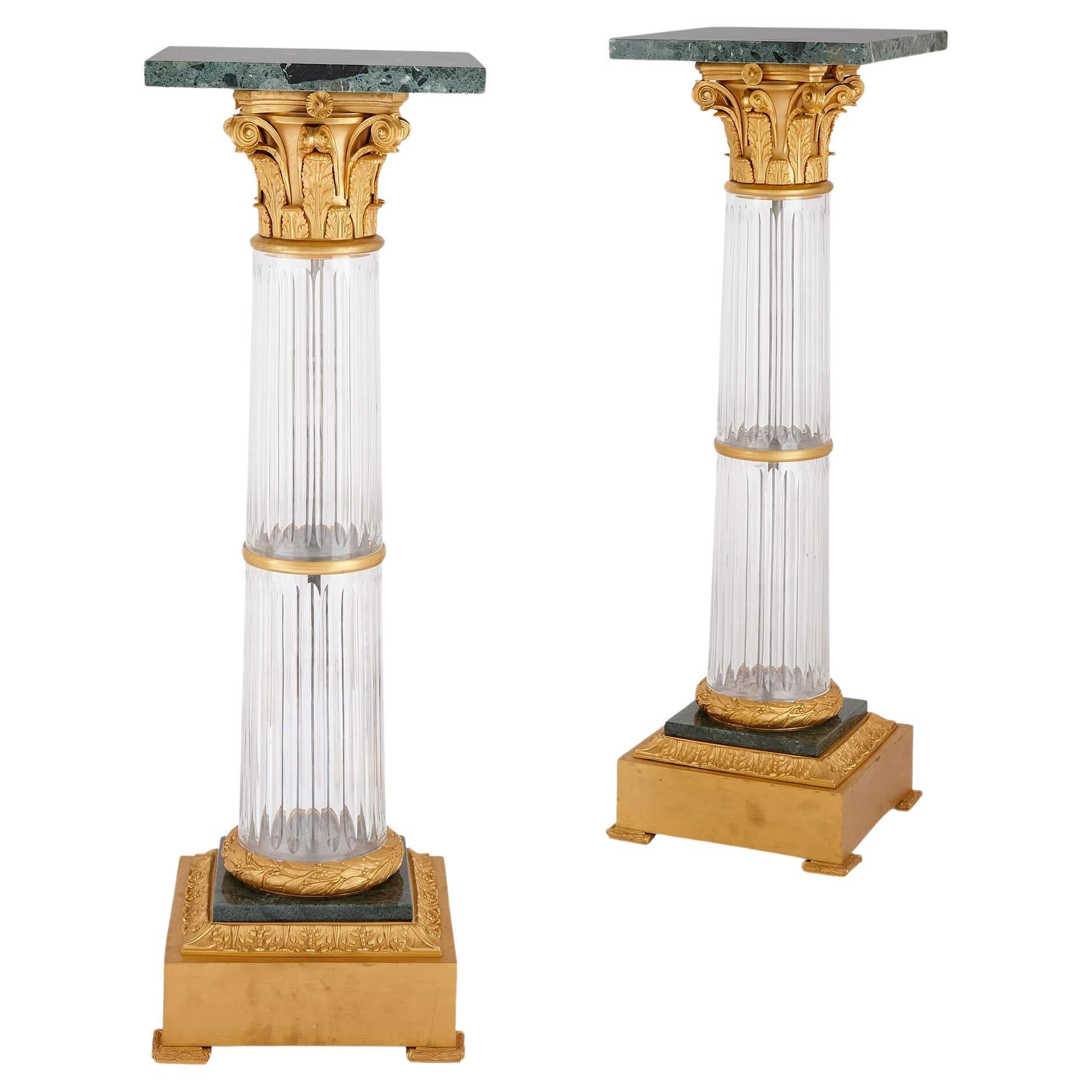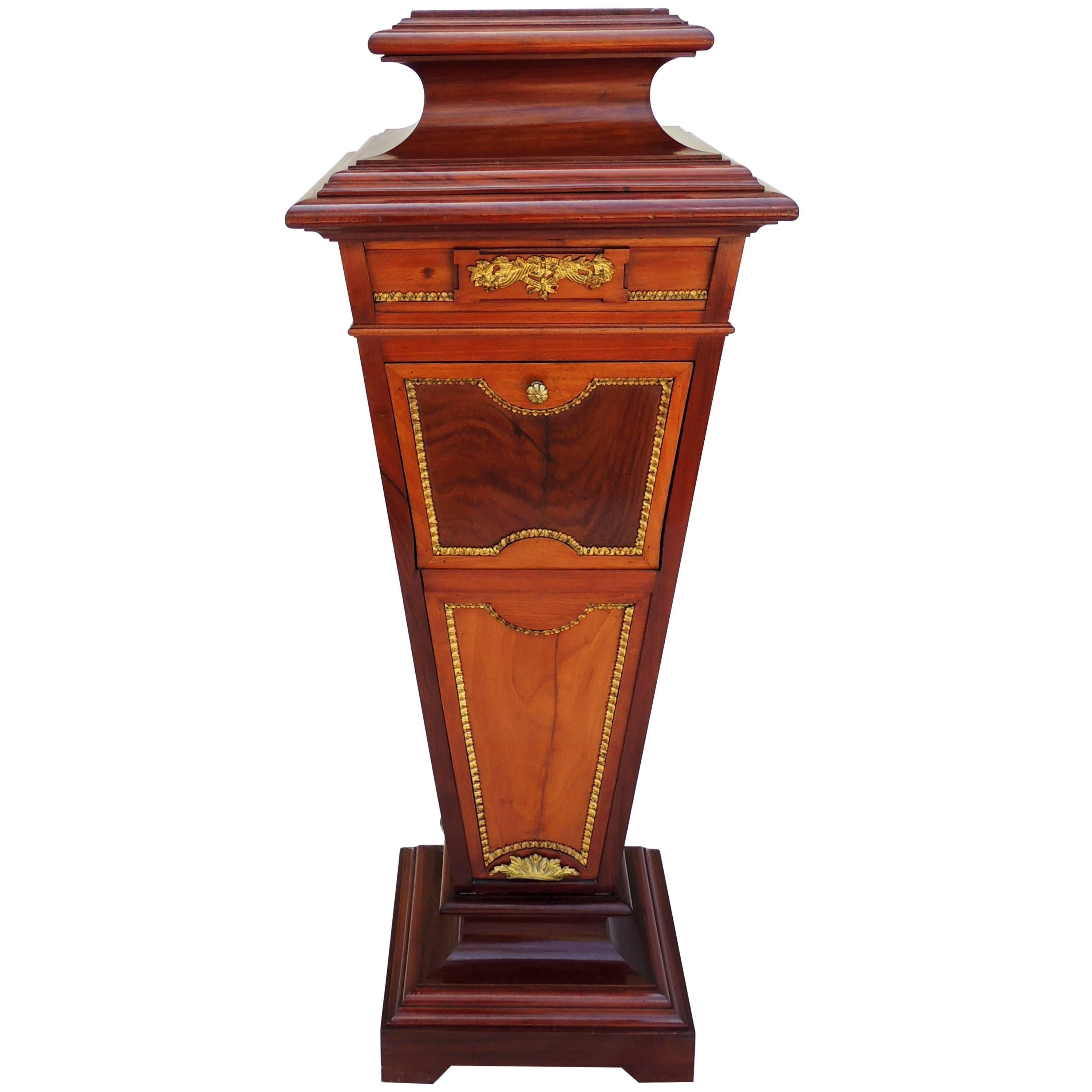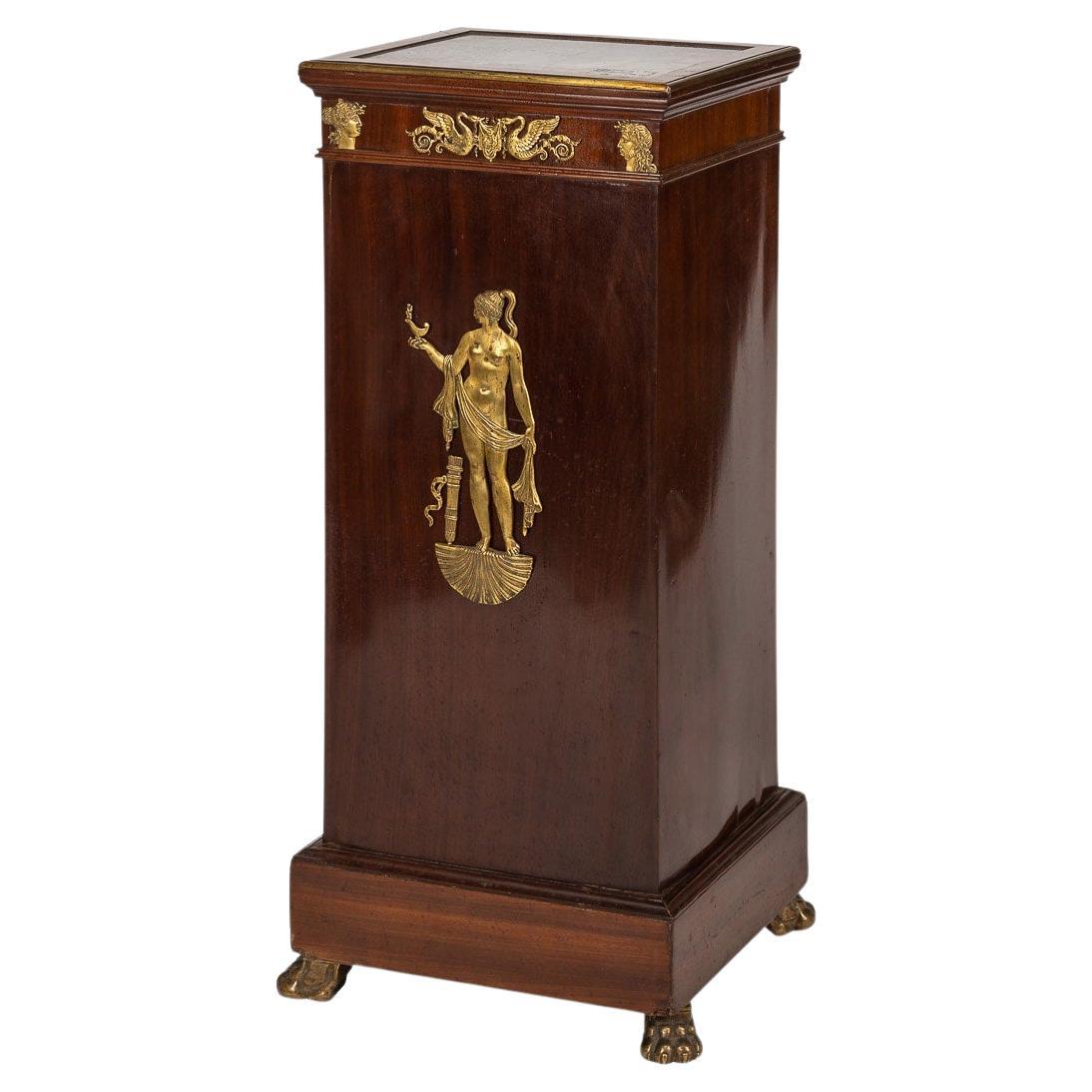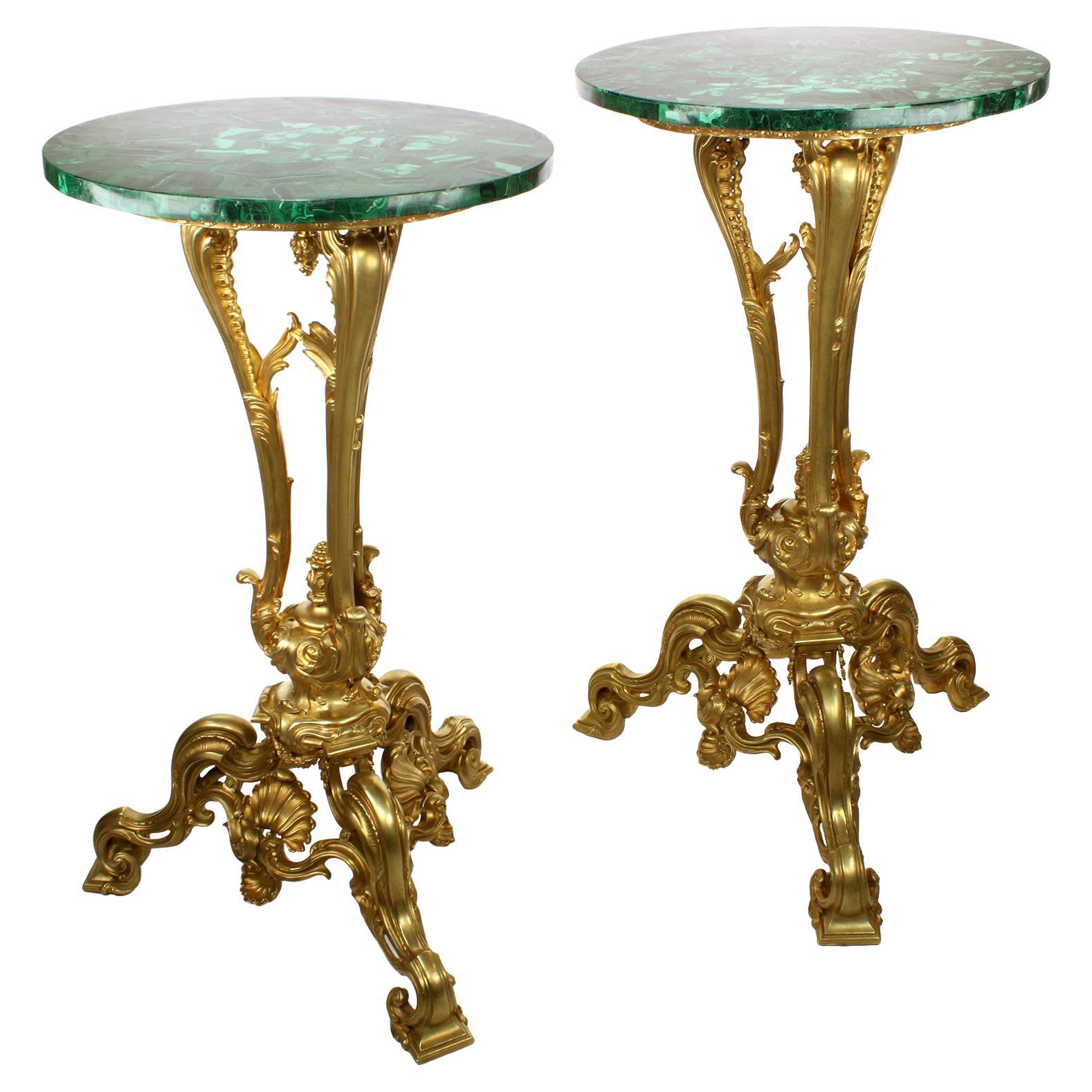Items Similar to French Ormolu Pedestal
Want more images or videos?
Request additional images or videos from the seller
1 of 5
French Ormolu Pedestal
About the Item
Tremendous size and exquisite ormolu detailing distinguish this important 19th-century French pedestal. Crafted of ebony and ebonized woods, this outstanding fixture boasts intricate brass inlay and bold ormolu of exceptional quality on all four sides. Standing just over six feet tall and raised upon ormolu lion’s paw feet, this large and strong pedestal was no doubt created to display a work of art, such as a fine sculpture or bronze masterpiece.
Circa 1880
27 1/2” wide x 17 1/2” deep x 72 1/4” high
- Dimensions:Height: 72.25 in (183.52 cm)Width: 27.5 in (69.85 cm)Depth: 17.5 in (44.45 cm)
- Style:Other (In the Style Of)
- Materials and Techniques:
- Place of Origin:
- Period:
- Date of Manufacture:circa 1880
- Condition:
- Seller Location:New Orleans, LA
- Reference Number:
About the Seller
5.0
Recognized Seller
These prestigious sellers are industry leaders and represent the highest echelon for item quality and design.
Established in 1912
1stDibs seller since 2010
93 sales on 1stDibs
Typical response time: 7 hours
- ShippingRetrieving quote...Ships From: New Orleans, LA
- Return PolicyThis item cannot be returned.
More From This SellerView All
- French Marble, Onyx, Enamel and Ormolu Pedestal ClockLocated in New Orleans, LAThis beautiful French vitrine clock styled in the Moroccan taste is an exquisite work of artistry and craftsmanship. Featuring a clock, thermometer and barometer, no detail has been overlooked regarding its functionality, design and construction. This magnificent clock rests on four bracket feet with gadrooned ormolu bases atop a square red marble plinth...Category
Antique Late 19th Century French Moorish Grandfather Clocks and Longcase...
MaterialsOnyx, Marble, Enamel, Ormolu
- Expanding Jupe Dining Table by Johnstone and JeanesBy Robert JupeLocated in New Orleans, LAThis exceptionally rare circular expanding dining table was designed by Robert Jupe and crafted by the English cabinetmakers Johnstone & Jeanes, successors to Johnstone, Jupe & Co. One of only a handful known from the firm, this table illustrates the Victorian era's quest to combine technical innovation with superb and beautiful craftsmanship. Complete with its original leaves, the table’s circular top is formed from eight separate segments. When the top is rotated, an ingenious swivel mechanism causes the sections to diverge, allowing a set of small or large leaves to be inserted for an adjustable increase in size. The design for the table was patented by Robert Jupe in 1835, who had envisioned “an improved expanding table so constructed that the sections composing its surface may be caused to diverge from a common center and that the spaces caused thereby may be filled up by inserting leaves or filling pieces.” The first of these fascinating tables were created between 1835 and 1840 during his partnership with John Johnstone and their firm of Johnstone, Jupe & Co. in London. Jupe left the company in 1840, after which the firm changed its name due to a new partnership and became Johnstone & Jeanes. The firm would eventually achieve international fame for its remarkable designs, exhibiting a "circular table made on the expanding principle" like this one at the Great Exhibition of 1851. Jupe was not alone in his fascination with combining the technical merits of engineering and mechanics with the more artful pursuit of cabinet making. The first half of the 19th century saw a prolific increase in the popularity of applying new ideas to furniture principles, which allowed furniture to serve many purposes. The resulting “patent” furniture...Category
Antique 19th Century English Victorian Dining Room Tables
MaterialsMahogany
- Regency-Era Card TableLocated in New Orleans, LAThis ingenious late Regency card table was designed with both beauty and entertainment in mind. When not in use, its folded D-shaped top sits against the wall providing an elegant si...Category
Antique Early 19th Century English Regency Game Tables
MaterialsWood
- Russian Malachite and Pietre Dure PlinthsLocated in New Orleans, LAThe exquisite art of pietre dure is at its absolute finest in this spectacular pair of Russian ormolu and malachite plinths. True works of art of the Restauration period, these plinths each feature a matching pietre dure mosaic crafted of the finest stones, all chosen to create a sense of depth and dimensionality in the final work. Depicting an onyx vase with tulips, roses, daffodils, magnolia and other flowers, these pietre dure panels are among the finest examples of this ancient art we have seen. The pietre dure is complemented by malachite panels of the highest quality, exhibiting exceptional depth through its extraordinary cellular structure. Malachite is one of Russia’s most precious stones, and its presence in these plinths indicates commission and ownership by an individual of considerable status. Mounted in an excellent stepped ormolu base, these plinths originally served as bases for vases or candelabra. The overall execution and appearance of these plinths is very characteristic of the taste associated with the immensely wealthy collector Nicolas Demidoff. As early as 1806, Demidoff had commissioned the Parisian goldsmith Henri August to supply a guéridon; in 1819, he ordered famed French bronzier Pierre-Philippe Thomire to supply mounts for a massive malachite vase (now in the Metropolitan Museum of Art, New York), as well as a console table with legs in the form of Nike. Other commissions included a table given as a gift to Grand Duke Leopoldo II of Florence, now in the Pitti Palace. Demidoff eventually settled in Florence in 1822 and became Russian minister to the Tuscan Court. Elevated to the rank of Count of San Donato by the Grand Duke, he built a magnificent villa at San Donato on the site of lands formerly owned by the Medici. The villa was later inherited by Anatole, his son, Prince of San Donato, and there are records which confirm transactions he had with the Opificio delle Pietre Dure. The 19th century proved to be the golden age of Russian malachite. The stone became a sign of prestige and a token of wealth, so much so that Russian papers of the time wrote: "To afford having a big piece wrought in malachite is synonymous to owning diamonds." Year after year the Russian (Romanov) treasury paid increasingly unreasonable prices to hoard the best malachite, much of which went into Romanov palaces and extravagant objets d'art. The Hermitage Museum possesses a collection of over two hundred examples of this “palatial” malachite...Category
Antique 19th Century Russian Pedestals
MaterialsMalachite, Ormolu
- French Fluorspar and Ormolu Clock GarnitureLocated in New Orleans, LAThis beautiful French clock garniture, styled in the Louis XV taste, is a charming work of artistry and craftsmanship. Crafted of richly veined and brightly-hued fluorspar mounted wi...Category
Antique 19th Century French Rococo Mantel Clocks
MaterialsStone, Bronze
- Rouge de France Marble Pedestal, 18th CenturyLocated in New Orleans, LAThis elegant Italian pedestal is hewn from a striking piece of Rouge de France marble. Quarried only in France, Rouge de France marble has been hotly sought-after since ancient times...Category
Antique 18th Century Italian Neoclassical Pedestals and Columns
MaterialsMarble
You May Also Like
- Magnificent French Neoclassical Ormolu Mounted Verdigris Marble PedestalLocated in West Palm Beach, FLMagnificent French Neoclassical Ormolu Mounted Verdigris Marble Pedestal France, Paris, Late 19th century This magnificent French neoclassical ormolu mounted verdigris marble pede...Category
Antique Late 19th Century French Neoclassical Pedestals
MaterialsMarble, Ormolu
- French Empire Ormolu-Mounted Vitrine Cabinet Pedestal, Circa 1840Located in New York, NYFrench Empire ormolu-mounted vitrine cabinet pedestal, circa 1840. Very good quality bronze mounts of typical Empire period heads. Very useful pedestal vitrine combination tha...Category
Antique Early 19th Century French Empire Pedestals
MaterialsBronze
- Pair of Large French Neoclassical Ormolu, Glass and Marble PedestalsLocated in London, GBPair of large French Neoclassical ormolu, glass and marble pedestals French, 20th century Height 112.5cm, width 36cm, depth 36cm These exceptional pieces are a pair of large Fre...Category
20th Century French Neoclassical Pedestals
MaterialsMarble, Ormolu
- Wonderful French Ormolu Bronze-Mounted Mahogany Pedestal Marble-Top DrawersLocated in Roslyn, NYWonderful French fine ormolu bronze-mounted mahogany pedestal with marble top and two drawers. Measures: 52" H x 16" W.Category
Vintage 1920s French Louis XVI Pedestals
MaterialsMarble, Bronze
- 19th Century French Empire Style Ormolu Mounted Wood & Marble Pedestal, C.1890Located in Royal Tunbridge Wells, KentAntique late 19th century French ormolu mounted Empire-style pedestal, cast and figurine depicting a Greek goddess along with sculpted heads overlaid with flora. The middle design de...Category
Antique 19th Century French Empire Pedestals
MaterialsMarble, Ormolu
- Pair French 19th Century Ormolu & Malachite Pedestal Side Tables, Attr F.E. PiatBy Frédéric - Eugène Piat 1Located in Los Angeles, CAA Palatial very fine and rare pair of French 19th century Louis XV style Ormolu and Malachite Pedestal side tables, attributed to Frédéric-Eugène Piat (French, 1827-1903), the bronze...Category
Antique 19th Century French Louis XV Side Tables
MaterialsMalachite, Bronze, Ormolu
Recently Viewed
View AllMore Ways To Browse
French Ormolu Table
French Ormolu Tables
Side Table Pedestal Feet
Black Pedestal Side Table
4 Pedestal Dining Table
Large Black Pedestal
Ormolu Ebonized
Inlay Table Ormolu
Large Tall Side Table
High Table Wood Pedestal
Large Ebony Table
Large Lion Wood
Large Display Pedestal
Wood Wide Pedestal
Black And Ormolu French Table
Bronze Pedestal Side Table
Lion Paw Pedestal Table
Bronze Ormolu Paw Feet





